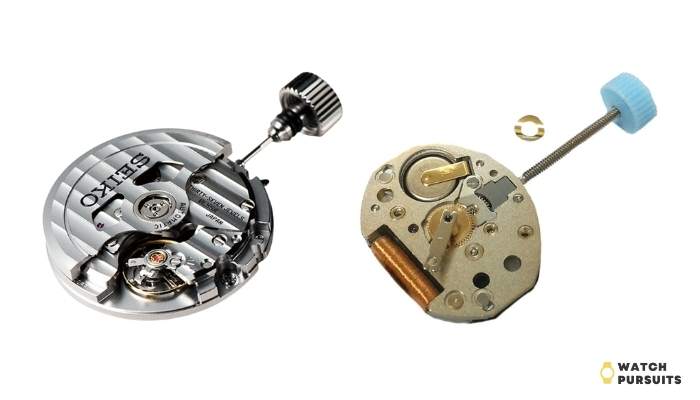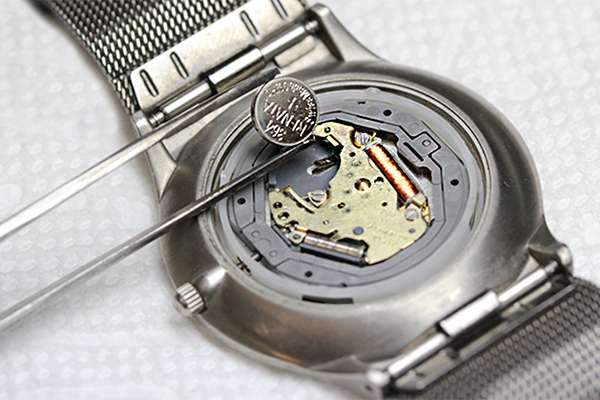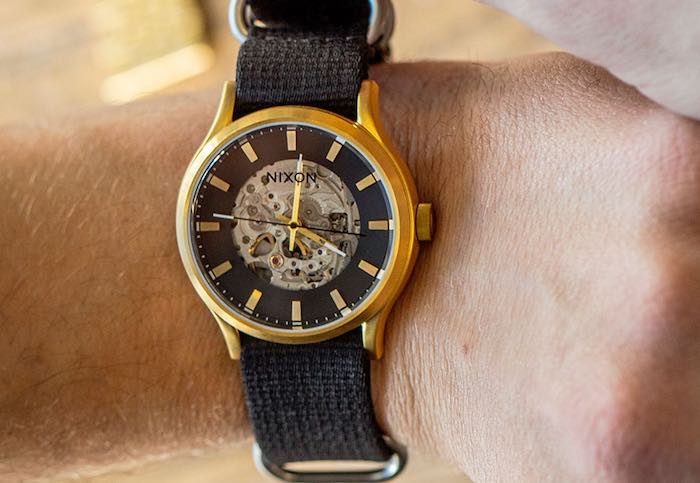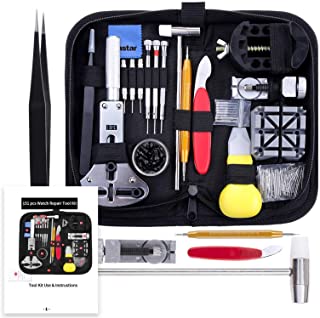Own a Nixon watch? you probably wonder the same question as well – how long do Nixon watch batteries last?
Depending on the movement, 2-5 years. This is because Nixon watches use multiple battery-powered movement types (quartz). How long do Nixon watch batteries last can also depend on the watch’s use condition. Wear the watch in very hot or very cold environment, and the battery might not last long.
Nixon specified that they mainly use quartz movements from Miyota on their website. Miyota is a Japanese watch movement maker under the Citizen watch group. Nixon also uses Swiss quartz movement from ISA and Ronda on their higher-end watches.
Why do some watches need a battery and some don’t?
This is due to the movements inside. Movements are the engine that power and run the watch.
Quartz movement typically needs a battery to power the movement. However, many advanced quartz movements have since moved to use kinetic energy (the wearer’s movement) or lights to power the watch.
Seiko‘s Kinetic (kinetic quartz) and Citizen’s Eco-Drive (light quartz) are examples of these movements.
Automatic watches also do not need a battery, as they are fully powered by your movement. When you swing your arms while walking, your movement will spin a rotor inside the watch.
The rotation on the rotor will wind up a spring inside the watch, and the energy will then slowly be used to run the watch’s hands.
Which Nixon Watches Need Battery? Which Don’t?
This will go back to the movement. Regular quartz watches from Nixon will need battery replacement every few years.
In contrast, those on automatic movements do not require batteries.
The easiest way to tell if a watch needs a battery is to observe how the second hand works.
The watch is a quartz movement if the second hand ‘jumps’ a position every second. It will require battery replacement at some point.
In automatic watches, you will see that the second hand constantly moves in a sweeping motion.
You can too observe the watch face and caseback and see if the word ‘quartz’ is written on them. If yes, then the watch will need a battery replacement.
You will read the word ‘automatic’ if the watch runs on automatic movement.
You can also try to place the watch right beside your ear. If the watch is a quartz, you will hear a ‘ticking’ sound every second.
Automatic watches will instead give you a more rapid, constant ticking sound.
Finally, you can always check with Nixon to confirm if your watch needs a battery replacement.
Most Nixon watches are quartz, with only those from the Elite Class collection running automatic movement.
How quartz watches work
A cell battery powers a circuit board that vibrates a quartz crystal at exactly 32768 times per second.
Each time the crystal vibrates to that number, an electric pulse is sent to the watch hands, moving them.
The second hand watch usually has the most ‘dramatic’ move, jumping from one position to another.
Most entry-level watches, including those from Nixon, run quartz movement.
Is quartz better than automatic watches?

Both quartz and automatic movements have their own strengths and weaknesses.
Automatic watches are good because they do not need battery replacement. The watch will practically run forever as long as you wind the springs every 1-2 days.
You wind the spring by wearing the watch and going about your day. Your arm movement will charge the watch.
You can also manually wind the watch – better automatic movements will have the feature.
Automatic watches also have a luxury feel, as they have a more rapid ticking sound. The second hand also sweeps instead of ticks.
Most luxury watchmakers also only offer their watches in automatic movement.
The weaknesses of automatic watches are that they require more maintenance and are more expensive to maintain.
Automatic watches are also fully mechanical inside, requiring regular servicing by a watchmaker.
Depending on the watch, services can range from $100-$200 to thousands if it is an ultra-luxury watch.
Quartz definitely is easier and cheaper to maintain than automatic watches.
It practically needs no maintenance aside from a battery change every few years. It is also cheaper to maintain since you do not need to take it for servicing.
The weakness of quartz watches is that they tend to look and feel a bit ‘cheap.’
ALSO READ: Automatic vs Quartz – Which One Suits You Better?
How to change a battery in a quartz watch?
You basically have three choices here:
First, go back to your watch seller. This is especially important since this will ensure you preserve your warranty with the company.
If you tamper with the watch, you are likely going to void your warranty.
Plus, changing the watch battery yourself will require you to spend money to get the right tools, and you also will need time to fiddle with your watch to try to do the job yourself.
This might be daunting if you are not familiar with watch parts
If your watch no longer has a warranty, and you do not want to fuss overdoing the job DIY, consider visiting your local watchmaker.
He would charge a fee, but consider the payment a way to buy yourself time and save yourself the hassle.
Plus, it is always good to spend money to support the local economy. Your local watchmaker is making an honest living, so why not?
Finally, if you are a true hardcore DIYer, you can do the job yourself.
It should not be an issue if you have the right tool to change the battery.
You will need a watch repair kit. Inside the kit, you will have all the tools to change your watch battery.
It would also be good to prepare a piece of microfibre cloth to use as a soft work surface and to wipe off any dirt that you might see on your watch.
How To Change Your Watch Battery Yourself?
- Turn your watch and observe the caseback. Most watches have a caseback that is either:
- Screwed down into the watch case entirely.
- Attached to the watch case using individual screws
- Snapped onto the watch case.
- If the caseback is screwed down to the case entirely, use the caseback opener tool to slowly twist open the caseback.
- Use precision screwdrivers to open the caseback, if they are screwed to the caseback.

- If the caseback is snapped on, use the pryer to pry open the caseback.
- Depending on your watch model, you might see some silicone/rubber/plastic coverings. Remove it to see your watch movement.
- Observe the battery holder. The battery is usually clipped on to the movement, with an opening. The opening is for you to insert or remove the battery.

- Use the tweezer and slowly nudge the battery towards the opening, to remove it.
- Observe the battery. Take note of the side that is facing up.

- You should be able to read some writing on the battery. Every cell battery has a letter and numbering format, which tells you the type, diameter, and height.
- For example, an CR2025 battery would mean:
- C = Lithium
- R = Round
- 20 = 20mm diameter
- 25 = 2.5 mm height
- The full details for the codes are available here.
- Once you make out this information, purchase your cell battery. Brands are not much of an issue, but it is best to order back the battery with the same exact code to ensure fit and consistent performance.
- If you cant, take the battery to a hardware shop, and ask them to match the right battery for you.
- Insert the new battery into the battery pocket in the watch. Use tweezers to slowly push the battery in.
- Turn the watch over and check your work. If the second hand moves again, you have to correctly place the battery.
- Put everything back in place, secure the caseback, and you are done!
So, How long do Nixon watch batteries last?
Let’s get back to the main topic again, to sum up this article. How long do Nixon watch batteries last?
In general, expect it to last 2-5 years, depending on the quartz movement inside. Condition of use also affects the battery’s longevity.
We also looked at how quartz watches work, compared to automatic watches, and options for replacing the watch battery.
Hope this article has been helpful to you, and feel free to reach out to us if you have any questions!


